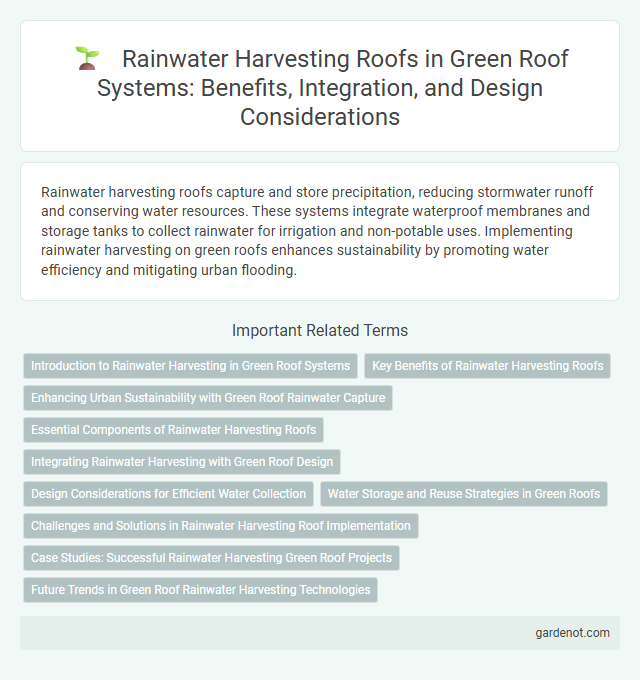Rainwater harvesting roofs capture and store precipitation, reducing stormwater runoff and conserving water resources. These systems integrate waterproof membranes and storage tanks to collect rainwater for irrigation and non-potable uses. Implementing rainwater harvesting on green roofs enhances sustainability by promoting water efficiency and mitigating urban flooding.
Introduction to Rainwater Harvesting in Green Roof Systems
Rainwater harvesting in green roof systems involves capturing and storing rainwater for reuse, reducing stormwater runoff and conserving water resources. Green roofs equipped with rainwater harvesting technology promote sustainable urban drainage by filtering and retaining rainwater through vegetation layers and growing media. Integrating rainwater harvesting with green roofs enhances water efficiency, mitigates flood risks, and supports irrigation needs for rooftop plants.
Key Benefits of Rainwater Harvesting Roofs
Rainwater harvesting roofs significantly reduce stormwater runoff, decreasing the risk of urban flooding and erosion while conserving valuable freshwater resources. These systems promote sustainable water management by capturing and storing rainwater for irrigation, toilet flushing, and cooling systems, leading to lower water bills and reduced demand on municipal water supplies. Furthermore, rainwater harvesting roofs improve building energy efficiency by reducing the strain on drainage infrastructure and enhancing roof insulation through integrated green roofing technologies.
Enhancing Urban Sustainability with Green Roof Rainwater Capture
Green roofs equipped with rainwater harvesting systems significantly reduce urban runoff by capturing and storing precipitation for reuse in irrigation and non-potable applications. This practice enhances urban sustainability by mitigating flood risks, conserving potable water resources, and improving stormwater management efficiency. Integrating green roof rainwater capture supports resilient city infrastructure while promoting biodiversity and reducing heat island effects.
Essential Components of Rainwater Harvesting Roofs
Essential components of rainwater harvesting roofs include a catchment area, typically a durable and clean roofing surface, to collect precipitation efficiently. A gutter and downspout system channels the collected water towards storage tanks, equipped with first-flush diverters to remove initial debris and contaminants. Filtration units and secure storage tanks ensure the harvested water remains clean and ready for irrigation, flushing, or groundwater recharge applications.
Integrating Rainwater Harvesting with Green Roof Design
Integrating rainwater harvesting with green roof design enhances stormwater management by capturing and utilizing runoff for irrigation and reducing urban water demand. This combination improves roof insulation, prolongs membrane lifespan, and supports plant growth through efficient water retention and controlled drainage. Advanced systems incorporate storage tanks and filtration units, optimizing water reuse while mitigating flood risks in urban environments.
Design Considerations for Efficient Water Collection
Rainwater harvesting roofs require precise design considerations such as selecting permeable surfaces and optimal slope angles to maximize water capture efficiency. Incorporating storage tanks with filtration systems ensures clean water retention and reduces runoff contamination. Strategic placement of gutters and downspouts directs water flow effectively, preventing overflow and enhancing overall collection capacity.
Water Storage and Reuse Strategies in Green Roofs
Rainwater harvesting in green roofs enhances water storage by integrating specialized layers that capture and retain runoff for extended periods. These systems reduce stormwater runoff, mitigate urban flooding, and promote sustainable water reuse for irrigation and non-potable applications. Advanced substrate mixes and water retention mats optimize moisture retention, supporting plant health while conserving water resources efficiently.
Challenges and Solutions in Rainwater Harvesting Roof Implementation
Rainwater harvesting roof systems face challenges such as limited storage capacity, contamination risks, and maintenance difficulties that hinder efficient water collection and reuse. Implementing robust filtration mechanisms, employing modular storage tanks, and establishing regular cleaning schedules effectively mitigate these issues. Advanced monitoring technologies also optimize system performance by detecting leaks and ensuring water quality compliance.
Case Studies: Successful Rainwater Harvesting Green Roof Projects
Case studies of rainwater harvesting green roof projects demonstrate significant urban water management improvements by reducing runoff and enhancing water reuse. The Chicago City Hall green roof captures rainwater for irrigation, showcasing a 40% reduction in municipal water demand. Similarly, the Milan Expo 2015 green roof integrates a rainwater harvest system that supports plant growth while mitigating stormwater overflow by 30%.
Future Trends in Green Roof Rainwater Harvesting Technologies
Emerging trends in green roof rainwater harvesting technologies include the integration of smart sensors and IoT devices to optimize water capture and usage efficiency. Advanced filtration systems using biochar and nanomaterials are being developed to improve water quality for reuse in irrigation and greywater applications. Future green roofs will increasingly incorporate modular, lightweight storage solutions that enhance rainwater retention while supporting urban sustainability and climate resilience goals.
Rainwater harvesting roof Infographic

 gardenot.com
gardenot.com